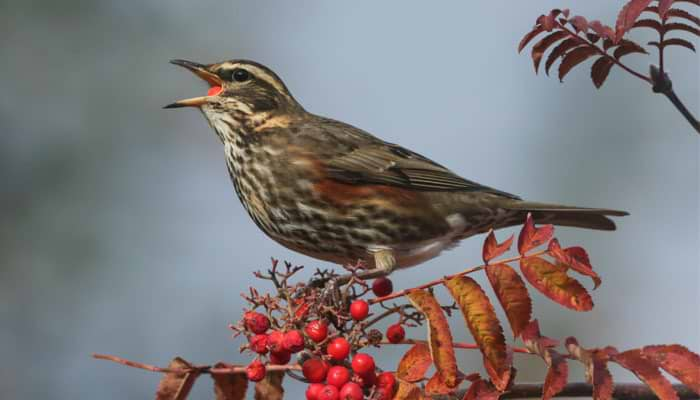
© Sandra Standbridge / Adobe Stock
February is traditionally the month when winter begins the gradual transition into spring. As the garden birds who have weathered the winter months are on the move, in their never-ending hunt for food, they will also begin their courtship displays later in the month. The weather influences how our UK garden birds will fare in February. At this time of year, as well as the pressure of long, cold nights and changeable days, natural food supplies start to run out. Which birds feed in gardens? The thrushes, tits and finches have spent the winter surviving on the remainder of autumn's fruits and produce. Sadly, some of them may not have survived the winter if food supplies have run out. By February, the autumnal supplies of berries, nuts and seeds are running low. Birds will take their chances and seek out food farther afield. This is the month when observers will see birds moving around a great deal, either in flocks, or in small groups and pairs, in the hunt for food. Many of the travelling birds will end up in gardens in February and March. Householders may spot some more exotic species, such as redwings and fieldfares, otherwise known as "winter thrushes". They sometimes seem to turn up overnight to hunt for berries in gardens. They may not get on with the regular resident birds and there may be discord, especially with mistle thrushes, who seek out berry-clad bushes. Unfortunately for the resident birds, the visitors often win, simply through being in a larger flock. They can strip your garden of berries in a very short time. How can you spot the visitors? The fieldfare is a very handsome bird. Larger than the blackbird, it has bold grey and ochre colouring, with chevron shapes on its breast. The redwing looks thrush-like, although it's smaller than the fieldfare. Its face features what looks like a bold eyebrow line and it has stunning reddish-brown plumage spreading from underneath its wings to its belly. This is where its name originates. Another February visitor is the tiny siskin, a member of the finch family. Notable for its green and yellow plumage, it used to be more prevalent in the countryside, feeding on alder seeds growing naturally. However, since the 1960s, it has been increasingly spotted in domestic gardens, where it enjoys feeding on peanuts and black sunflower seeds. How can people help wildlife? We have always put food out and tried to make our garden welcoming for birds in the colder months. The healthiest types of wild bird food are high in fat and oil such as suet, peanuts, sunflower seeds and even peanut butter. Leave out fresh, clean water too, for drinking and bathing in. Change it every day and make sure it doesn't freeze over. If you really want to attract birds, invest in a heated birdbath. You can also add bird boxes, so your garden visitors may roost there and lay their eggs. Choose nesting boxes that are as safe as possible from cats and other predators and keep them facing away from northern winds, or wide-open spaces, to make them cosy and warm. Gardens with plenty of evergreen shrubs and trees will also provide natural nesting places for birds. Is global warming affecting birds? Although February has traditionally been a colder month in the past, in recent years, the Met Office says it has warmed up as a result of global warming. February 1963 was part of the third-coldest winter since records began in 1659. All across the UK, people struggled with weather that became known as the Big Freeze. February saw snow, Gale Force 8 winds and even a 36-hour blizzard! In the 21st century, the coldest winter to date was December 2010 to early February 2011. Since then, we have experienced milder weather in the month of February on average. Scientists believe this is having an effect on our garden birds, who are said to be "confused" by the unseasonal warm climate. Research reported by the National Trust claimed the mild winter of 2017-2018 caused flowers and other foliage to bloom early - bees were out and about pollinating them much earlier than usual. Wild birds were tricked into thinking it was spring and they began nesting early too! What are the pros and cons of warmer winters? The RSPB said the mild weather was encouraging species that normally migrated to stay in the UK - such as swallows and willow warblers. It was reported that the number of birds spending winter on the warmer Suffolk coast had dropped in recent years, disappointing bird-watching visitors, who looked forward to their winter arrival. Other species that aren't normally spotted in the UK until summer have also been reported in the winter months – including swifts, whinchat and wheatear. Birds of prey and owls appear to be benefiting, as the milder winters mean more rodents are around, providing a greater food source. According to the British Trust for Ornithology, one of the negative impacts of the warmer weather was the spread of disease. While the cold winter weather normally killed off any diseases that affected garden birds, the mild weather was allowing bacteria to multiply. The BTO has reported an increase in reports of sick garden birds, coinciding with the warmer winters. Keeping the birds' drinking water in your garden scrupulously clean is one way of helping to keep harmful bacteria down. If you enjoy watching and feeding the birds, dress up warm! MA Grigg's branded range of country clothing has something for everyone, no matter what the weather.




